#EVOlution
Explore tagged Tumblr posts
Text

Spiraling regrets.
So that diving bell, huh… Featuring a woolly siphonophore, one of my personal favorites sea/zee beasts.
#zeeposting#my art#fallen London#evolution#I really enjoyed this park of Evo Ough…#finally felt up to drawing something kinda quick#so here we go#my pet tube :)
125 notes
·
View notes
Text




Flocking 2-7-25 (and a cameo appearance from Garfield)
Really enjoyed this one! Fukuisaurus, Cartorhynchus, Nanuqsaurus, and Stethacanthus!
90 notes
·
View notes
Text

Are there possibly too many eyes??
#eyes and ears#life series#traffic smp#trafficblr#the watchers#watcher lore#evo smp#evolution#martyn inthelittlewood#grian#watcher grian
33 notes
·
View notes
Text

All roads lead to Rome, all lineages evolve to CRAB 🦀🦀
35K notes
·
View notes
Text

Grounded Flight
2024, decolorant screenprint on quilted cotton
20K notes
·
View notes
Text
Yellowjacket-Mimicking Moth: this is just a harmless moth that mimics the appearance and behavior of a yellowjacket/wasp; its disguise is so convincing that it can even fool actual wasps

This species (Myrmecopsis polistes) may be one of the most impressive wasp-mimics in the world. The moth's narrow waist, teardrop-shaped abdomen, black-and-yellow patterning, transparent wings, smooth appearance, and folded wing position all mimic the features of a wasp. Unlike an actual wasp, however, it does not have any mandibles or biting/chewing mouthparts, because it's equipped with a proboscis instead, and it has noticeably "feathery" antennae.
There are many moths that use hymenopteran mimicry (the mimicry of bees, wasps, yellowjackets, hornets, and/or bumblebees, in particular) as a way to deter predators, and those mimics are often incredibly convincing. Myrmecopsis polistes is one of the best examples, but there are several other moths that have also mastered this form of mimicry.

Above: Pseudosphex laticincta, another moth species that mimics a yellowjacket
These disguises often involve more than just a physical resemblance; in many cases, the moths also engage in behavioral and/or acoustic mimicry, meaning that they can mimic the sounds and behaviors of their hymenopteran models. In some cases, the resemblance is so convincing that it even fools actual wasps/yellowjackets.

Above: Pseudosphex laticincta
Such a detailed and intricate disguise is unusual even among mimics. Researchers believe that it developed partly as a way for the moth to trick actual wasps into treating it like one of their own. Wasps frequently prey upon moths, but they are innately non-aggressive toward their own fellow nest-mates, which are identified by sight -- so if the moth can convincingly impersonate one of those nest-mates, then it can avoid being eaten by wasps.

Above: Pseudosphex laticincta
I gave an overview of the moths that mimic bees, wasps, yellowjackets, hornets, and bumblebees in one of my previous posts, but I felt that these two species (Myrmecopsis polistes and Pseudosphex laticincta) deserved to have their own dedicated post, because these are two of the most convincing mimics I have ever seen.

Above: Pseudosphex sp.
I think that moths in general are probably the most talented mimics in the natural world. They have so many intricate, unique disguises, and they often combine visual, behavioral, and acoustic forms of mimicry in order to produce an uncanny resemblance.
Several of these incredible mimics have already been featured on my blog: moths that mimic jumping spiders, a moth that mimics a broken birch twig, a moth caterpillar that can mimic a snake, a moth that disguises itself as two flies feeding on a pile of bird droppings, a moth that mimics a dried-up leaf, a moth that can mimic a cuckoo bee, and a moth that mimics the leaves of a poplar tree.
Moths are just so much more interesting than people generally realize.
Sources & More Info:
Journal of Ecology and Evolution: A Hypothesis to Explain Accuracy of Wasp Resemblances
Entomology Today: In Enemy Garb: A New Explanation for Wasp Mimicry
iNaturalist: Myrmecopsis polistes and Pseudosphex laticincta
Transactions of the Entomological Society of London: A Few Observations on Mimicry
#entomology#arthropods#lepidoptera#yellowjacket-mimicking moth#wasp-moth#clearwing moths#animal camouflage#myrmecopsis polistes#pseudosphex laticincta#pseudosphex aequalis#moths#insects#bugs#mimicry#evolution#hymenopteran mimics#defense mechanisms#animal facts#wasps#yellowjackets#moths are amazing#and wildly underrated
10K notes
·
View notes
Photo
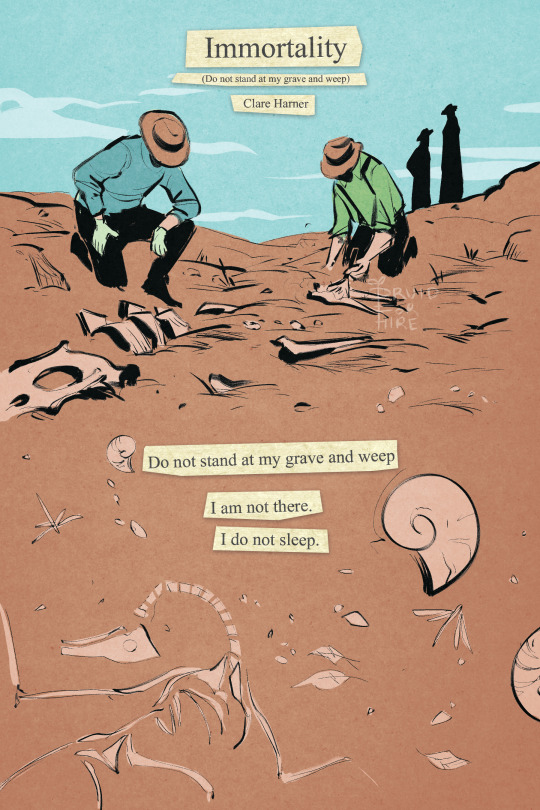
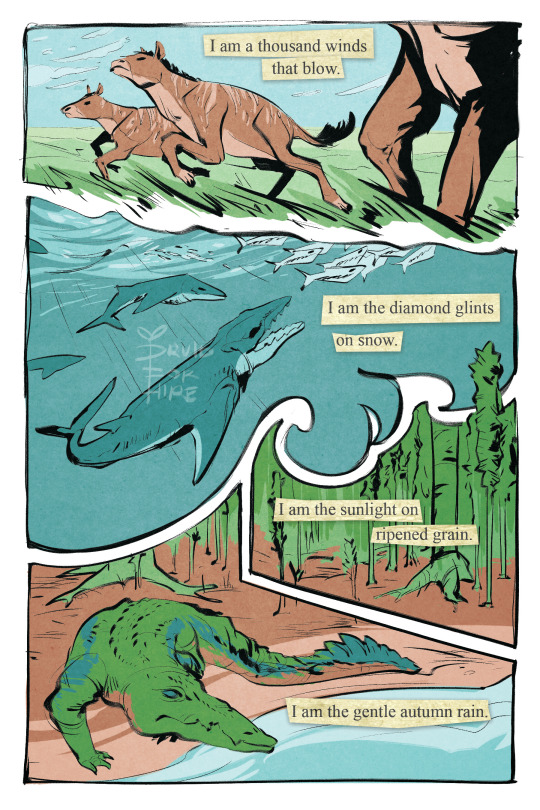
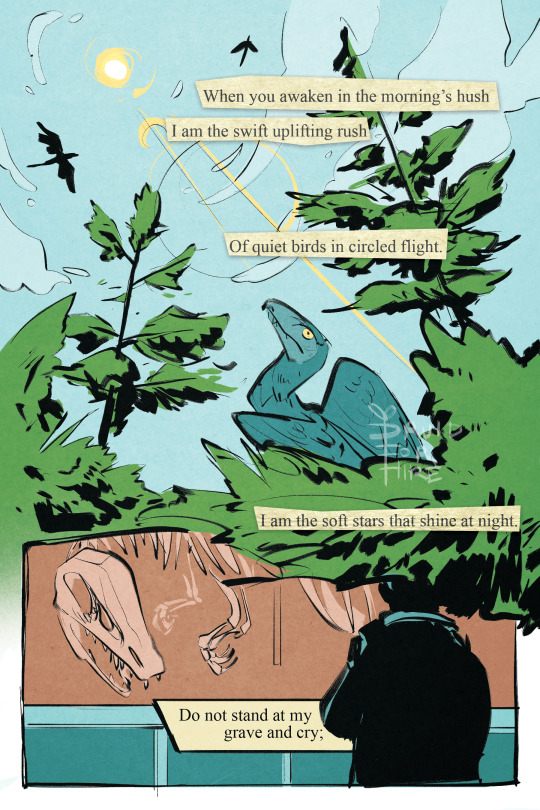
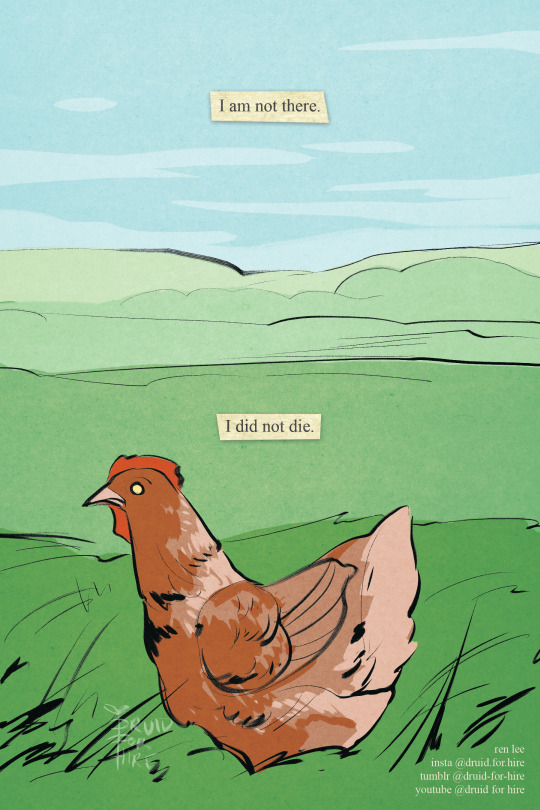
[image id: a four-page comic. it is titled "immortality” after the poem by clare harner (more popularly known as “do not stand at my grave and weep”). the first page shows paleontologists digging up fossils at a dig. it reads, “do not stand at my grave and weep. i am not there. i do not sleep.” page two features several prehistoric creatures living in the wild. not featured but notable, each have modern descendants: horses, cetaceans, horsetail plants, and crocodilians. it reads, “i am a thousand winds that blow. i am the diamond glints on snow. i am the sunlight on ripened grain. i am the gentle autumn rain.” the third page shows archaeopteryx in the treetops and the skies, then a modern museum-goer reading the placard on a fossil display. it reads, “when you awaken in the morning’s hush, i am the swift uplifting rush, of quiet birds in circled flight. i am the soft stars that shine at night. do not stand at my grave and cry.” the fourth page shows a chicken in a field. it reads, “i am not there. i did not die” / end id]
a comic i made in about 15 hours for my school’s comic anthology. the theme was “evolution”
#dinosaur#evolution#comic#prehistoric#animal#wildlife#paleontology#biology#poetry#comics#original#my art#archaeopteryx has no direct living descendants i know#but i wanted something aerial and the dinosaur to bird connection is classic and well known anyway#also the chicken over any other bird is very on purpose#its the mix of truth and comedy and genuineness and the fantastic in the mundane#its me asking you to see something so wonderful in something taken so un-seriously#and to love it both ways#also the jurassic park thing#where someone saw the reconstructed gait of a dino#and said. hey hang on. i know that walk.#and pulled up footage of a chicken walking#which jumpstarted the entire study into the link between dinosaurs and birds#in the end take whatever you want from it i just thought id provide some insight#i always like it when other artists do#the point is that i enjoy when people laugh at the end and when they dont#and i like it when they cry. i like it best when they both laugh and cry. eeaao intent#anyway mourn your losses but to live is to change#also hi guys i finally figured out tipping after 5 months so no more annoying ko-fi link#the antidote to despair is awe
152K notes
·
View notes
Text
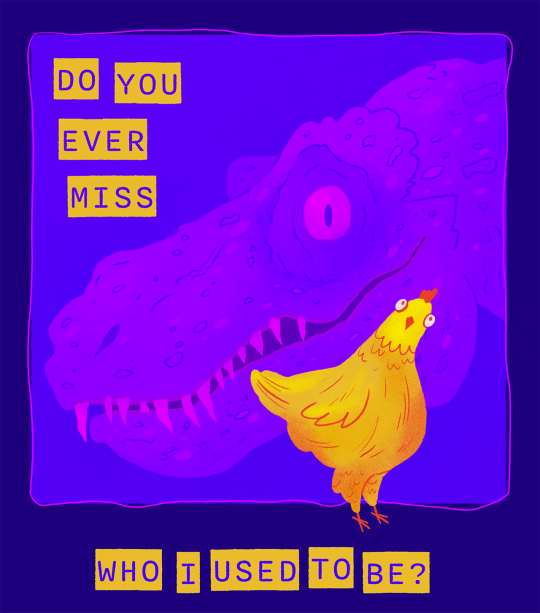
i promise i wouldn't blame you
#illustration#artists on tumblr#digital art#comic#dinosaur#chicken#art#artwork#drawing#webcomic#theartofmadeline#something i sketched ageeeeessss ago and never made hehe#no i dont know how to draw chickens or dinos. mind your business !!#bird#paleo art#evolution
48K notes
·
View notes
Text
[Update] Volunteers are helping the National Park Service in an effort to save Joshua Trees from extinction. They call themselves...
just learned that magnolias are so old that they’re pollinated by beetles because they existed before bees
#extinction#climate change#ecological anachronism#evolution#deep time#bee#mammoths#ground sloth#orchid#joshua trees
388K notes
·
View notes
Text

BOW DOWN TO THE ANCIENT ONE
55K notes
·
View notes
Text
If you've seen trivia posts going around, may have seen ones about the baculum, a bone in the penis whose purpose is to help support erections which is present in most placental mammals, including non-human apes, but which is conspicuously absent in humans.
Those posts typically don't go into why this is the case, which is fair enough, since the question is far from settled. However, there are a lot of hypotheses about it, and some of them are pretty fucking wild.
I think my personal favourite is the recently proposed idea that, since soft tissue injuries tend to heal more rapidly and completely than broken bones, a flexible and resilient boneless penis constitutes a reproductive advantage in situations where genital trauma is common, possibly as a result of the development of upright posture rendering the penis more prone to blunt encounters.
Like, imagine humanity's proto-hominid ancestors going "actually, bipedalism is great" and promptly getting whacked in the ding so much that it exerted evolutionary pressure on the morphology of the penis.
#science#biology#evolution#history#penis mention#violence mention#injury mention#genital trauma mention#swearing
18K notes
·
View notes
Text
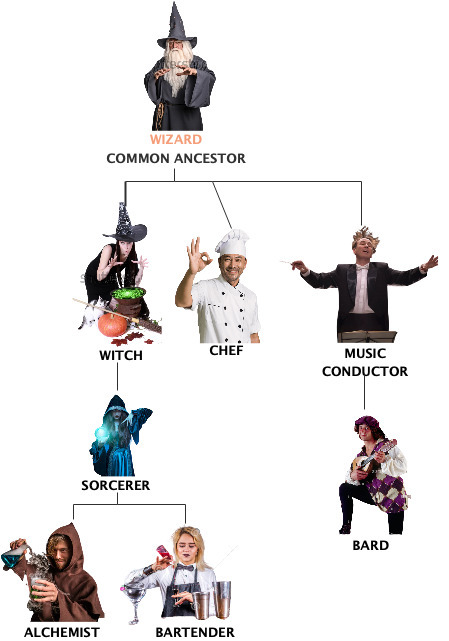
Further new discoveries have been made on my theory.
44K notes
·
View notes
Text

Thank you Grandpa Iridescence…
5K notes
·
View notes
Text







fantasizing about evolution by フキダシコットン on X
#pokemon#illustration#evolution#natu#kabuto#wurmple#quaxly#kricketot#klefki#pineco#nintendo#switch#3ds#anime#gaming#video games#retrogaming#artwork
7K notes
·
View notes